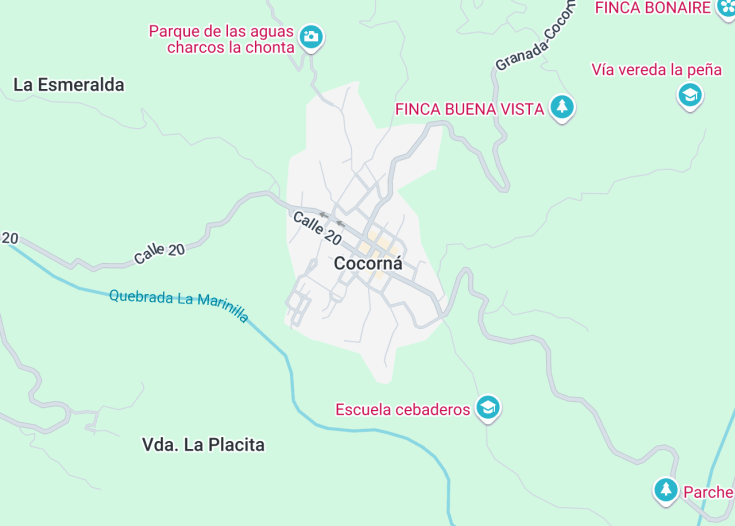Located in the heart of Colombia, Cocorná is a hidden gem that offers lush landscapes and a tranquil escape from the hustle and bustle of the city life. This picturesque town is surrounded by rolling hills and pristine rivers, perfect for nature lovers and adventure seekers. With its rich biodiversity, Cocorná is an ideal spot for bird watching, hiking, and water rafting.
Visitors can also immerse themselves in the local culture by engaging with friendly community members and experiencing traditional Colombian festivities. Cocorná’s warm climate and welcoming atmosphere make it a perfect year-round destination for those looking to connect with nature and enjoy peace.
For an enriching experience, engage with local guides who can provide insights into Cocorná’s unique ecological and cultural treasures.
Plan to visit during local festivals to enjoy traditional music, dances, and cuisines that showcase the rich cultural heritage of Cocorná.
Top things to do & see in Cocorna
Select the following sights and activities to discover best tickets and tours available in Cocorna.
Cocorna: A Hidden Gem in Colombia
| Country | Colombia |
| Time in Cocorna | GMT-5 |
| Language spoken | Spanish |
| Population | 12,000 (Source: Colombia Census Bureau) |
| Currency | Colombian Peso (COP $) |
| Airports |
|
Cocorna, located in the heart of Colombia, is a picturesque town filled with lush green landscapes and a rich cultural heritage. Known for its breathtaking natural beauty, Cocorna is surrounded by verdant mountains and clear streams that attract adventure seekers and nature enthusiasts alike. The town offers a variety of activities such as hiking, paragliding, and river rafting, making it a popular destination for those who seek outdoor thrills.
The history of Cocorna is marked by the stories of indigenous tribes and Spanish colonization, where traditional customs intertwine with colonial influences. Visitors to Cocorna can explore old churches and colonial-style homes that offer a glimpse into the past. The town also hosts various festivals showcasing traditional dance, music, and local cuisine, providing an immersive cultural experience.
Cocorna’s economy is primarily based on agriculture, with coffee and panela (unrefined whole cane sugar) being the major products. The fertile soils and ideal climate contribute to the high-quality produce that is cherished both locally and globally. Additionally, the town’s commitment to sustainable practices helps in maintaining a balanced ecosystem.
Despite its many attractions, Cocorna remains relatively undiscovered by mass tourism, allowing it to preserve its natural beauty and tranquil atmosphere. Whether you’re looking to explore the rugged terrain or immerse yourself in local traditions, Cocorna offers an authentic Colombian experience that is unmatched in its charm and warm hospitality.
Where is Cocorna?
Located in the Antioquia department of Colombia, Cocorna is nestled in the Andes mountains, providing scenic views and a serene environment.
Distances:
| Route | Distance by car | Time by car |
|---|---|---|
| Medellin to Cocorna | 44 miles | 1 hour 30 minutes |
| Bogota to Cocorna | 150 miles | 3 hours |
What is Cocorna famous for?
Cocorna is renowned for its enthralling outdoor activities. Its spectacular river gorges and verdant valleys make it an ideal spot for paragliding, providing breathtaking aerial views of the Colombian landscape.
History
Pre-Colonial Era (Before the 16th Century)
The history of Cocorná, a small town nestled in the department of Antioquia, Colombia, begins long before the arrival of Spanish conquerors. The region was originally inhabited by the Tahamíes indigenous people, who were part of the larger Carib linguistic group. The Tahamíes led a peaceful life, engaging in agriculture, hunting, and fishing along the verdant riverbanks and lush landscapes of the area now known as Cocorná. Their society was organized in small familial clans, each governing itself through a communal system.
Colonial Era (16th – 18th Century)
The arrival of Spanish explorers in the 16th century marked a turning point in the history of Cocorná. The Spanish were drawn to the region by its natural resources and strategic location. By the mid-16th century, the town had become an important hub for gold mining, significantly altering the social and environmental landscape. The colonial period saw the construction of churches, roads, and the introduction of European agriculture techniques, which were superimposed on the traditional ways of the indigenous people. Many of the Tahamíes were displaced or assimilated, leading to a profound change in the region’s cultural composition.
Post-Independence Era (19th Century – 20th Century)
Following Colombia’s independence from Spain in 1819, Cocorná experienced several transformations. The 19th century was marked by political instability that impeded economic growth, yet the town slowly started to stabilize and flourish by the advent of coffee cultivation, which became the staple of its economy. The 20th century brought infrastructural developments such as roads and telecommunication systems, linking Cocorná more closely with Medellín and facilitating economic progress. Social structures evolved, and the town saw increased investment in education and health services.
Modern Day (21st Century)
Today, Cocorná has embraced its heritage and landscapes to develop a growing tourism industry. Conservation efforts are in place to protect its rich biodiversity and the remnants of its pre-Colonial past. Recent initiatives also promote sustainable agriculture and ecotourism, which provide new opportunities for local residents while preserving the town’s environmental assets and cultural legacy.
Visit Cocorna
What to see and do in Cocorna, Colombia
Visitors to Cocorná will find a wealth of natural beauty and cultural heritage to explore. The town is surrounded by lush green mountains, pristine rivers, and waterfalls, offering ample opportunities for outdoor activities such as hiking, kayaking, and bird watching.
For those interested in history, the local church and the small town square provide a glimpse into the region’s colonial past. Additionally, a visit to the Cocorná Historical Museum offers insights into the town’s pre-Colonial and colonial history.
- Explore the Rio Claro Valley for exceptional natural scenery and adventure sports.
- Visit the local coffee plantations to learn about coffee production and sample some of the local brews.
- Take a guided tour to discover the indigenous heritage of the region.
Festivals and Celebrations in Cocorna
Cocorná hosts several cultural festivals and events throughout the year, celebrating its rich traditions and communal spirit. Noteworthy among them is the Festival of the Orchids in August, where locals and visitors alike marvel at the beauty of these exotic flowers, which thrive in the region’s climate.
Another significant event is the Town Anniversary on May 3, featuring parades, music, and traditional dance performances, reflecting the lively cultural tapestry of Cocorná.
Best time to visit Cocorna
The best time to visit Cocorná is between December and March when the weather is dry, making it ideal for exploring the natural landscapes and participating in outdoor activities. These months also coincide with several local festivals, offering an enriched experience of the town’s cultural vibrancy.
Is Cocorna worth visiting?
Cocorná is undoubtedly worth visiting for those who cherish nature, culture, and history. The town provides a tranquil retreat with its stunning natural scenery and offers a deep dive into the traditions and history of the Antioquia region.
Its growing focus on sustainable tourism and ecotourism makes it an appealing destination for environmentally conscious travelers looking to experience authentic Colombia.










